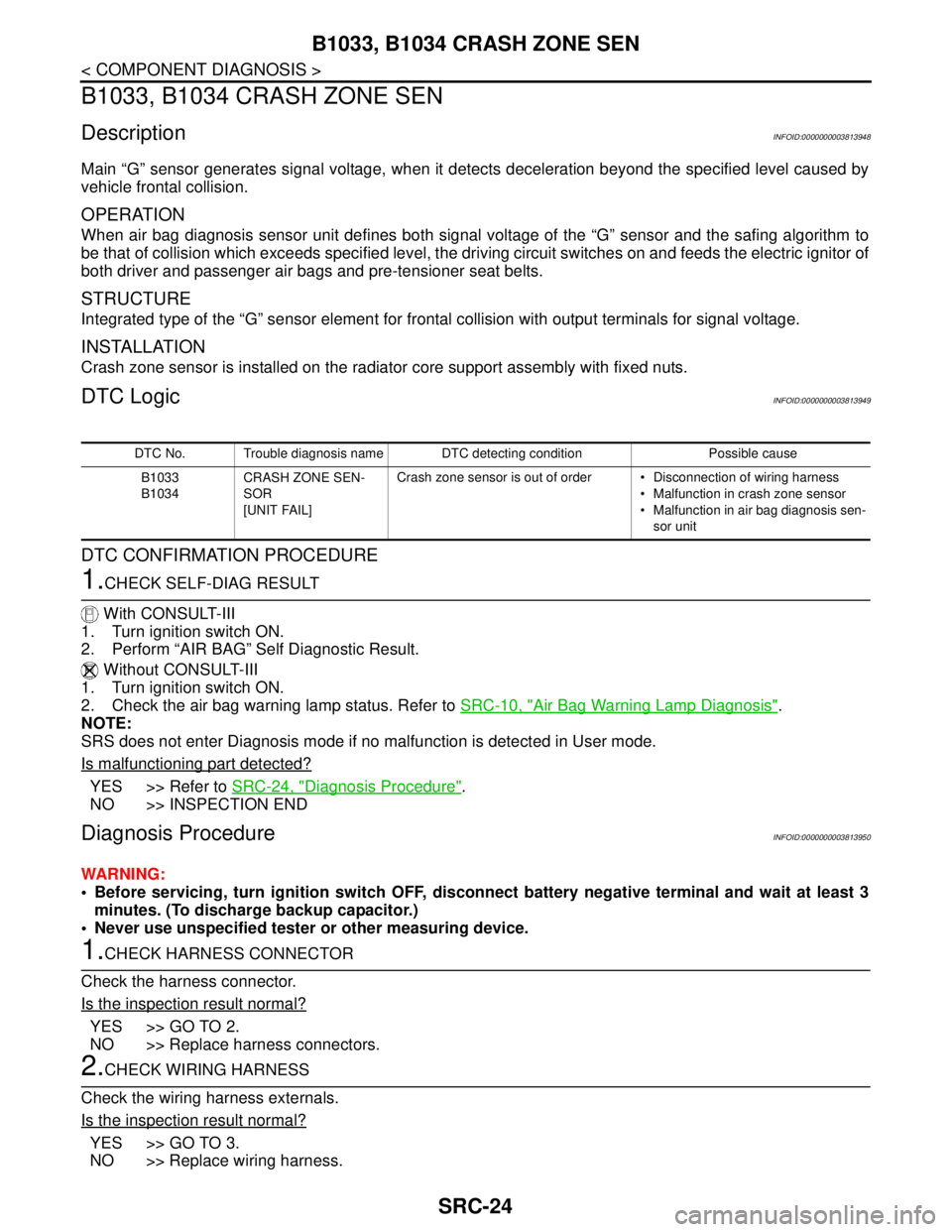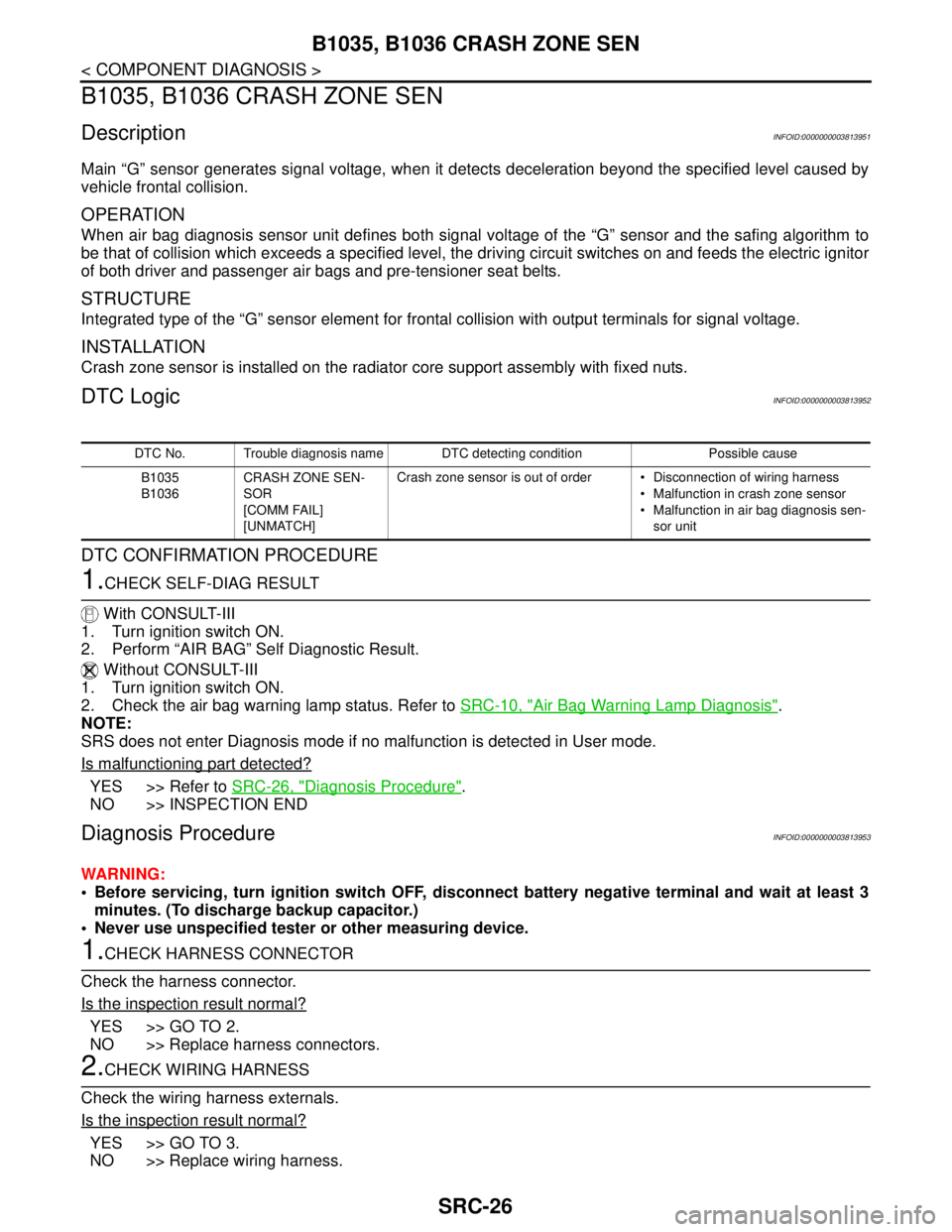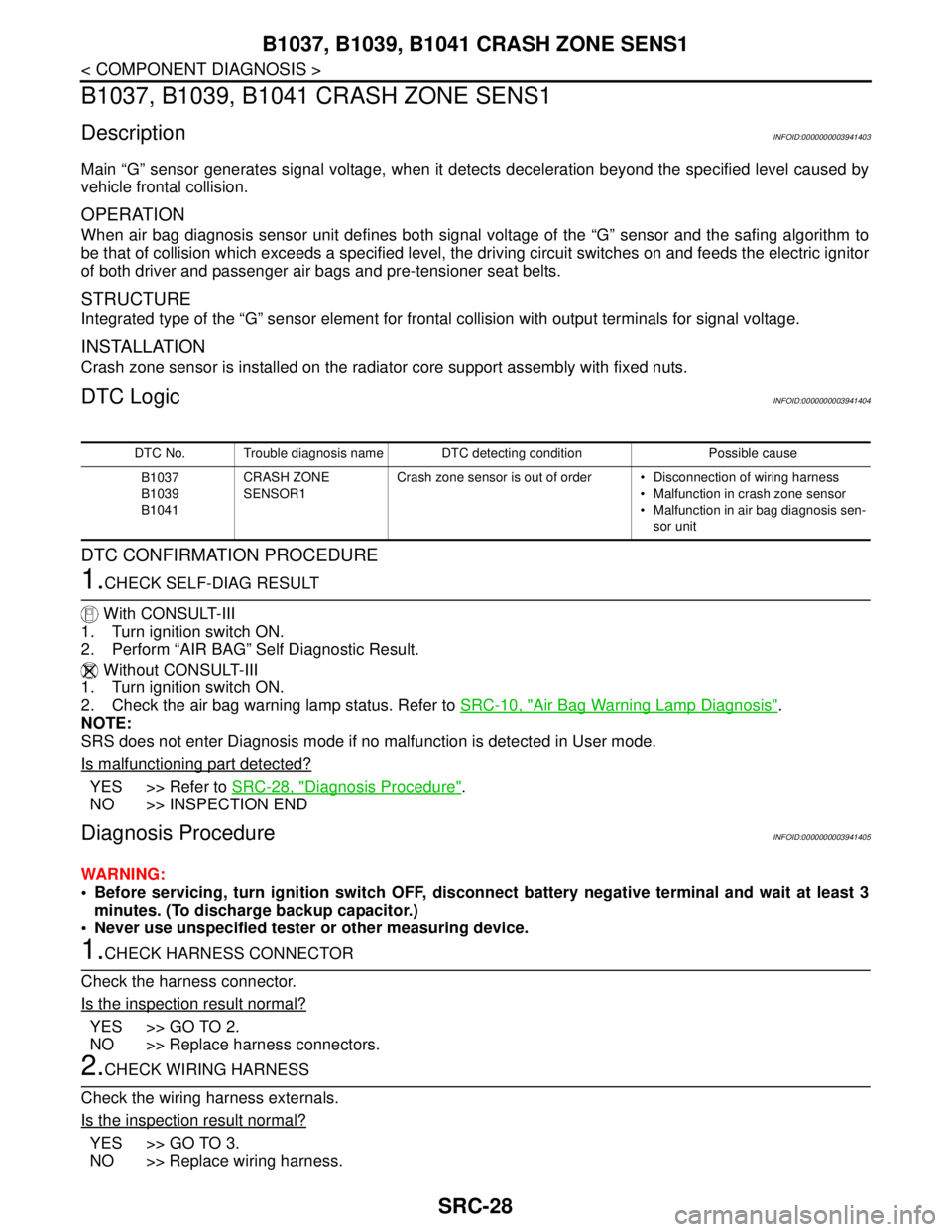2008 NISSAN TEANA radiator cap
[x] Cancel search: radiator capPage 4267 of 5121

SRC-24
< COMPONENT DIAGNOSIS >
B1033, B1034 CRASH ZONE SEN
B1033, B1034 CRASH ZONE SEN
DescriptionINFOID:0000000003813948
Main “G” sensor generates signal voltage, when it detects deceleration beyond the specified level caused by
vehicle frontal collision.
OPERATION
When air bag diagnosis sensor unit defines both signal voltage of the “G” sensor and the safing algorithm to
be that of collision which exceeds specified level, the driving circuit switches on and feeds the electric ignitor of
both driver and passenger air bags and pre-tensioner seat belts.
STRUCTURE
Integrated type of the “G” sensor element for frontal collision with output terminals for signal voltage.
INSTALLATION
Crash zone sensor is installed on the radiator core support assembly with fixed nuts.
DTC LogicINFOID:0000000003813949
DTC CONFIRMATION PROCEDURE
1.CHECK SELF-DIAG RESULT
With CONSULT-III
1. Turn ignition switch ON.
2. Perform “AIR BAG” Self Diagnostic Result.
Without CONSULT-III
1. Turn ignition switch ON.
2. Check the air bag warning lamp status. Refer to SRC-10, "
Air Bag Warning Lamp Diagnosis".
NOTE:
SRS does not enter Diagnosis mode if no malfunction is detected in User mode.
Is malfunctioning part detected?
YES >> Refer to SRC-24, "Diagnosis Procedure".
NO >> INSPECTION END
Diagnosis ProcedureINFOID:0000000003813950
WARNING:
Before servicing, turn ignition switch OFF, disconnect battery negative terminal and wait at least 3
minutes. (To discharge backup capacitor.)
Never use unspecified tester or other measuring device.
1.CHECK HARNESS CONNECTOR
Check the harness connector.
Is the inspection result normal?
YES >> GO TO 2.
NO >> Replace harness connectors.
2.CHECK WIRING HARNESS
Check the wiring harness externals.
Is the inspection result normal?
YES >> GO TO 3.
NO >> Replace wiring harness.
DTC No. Trouble diagnosis name DTC detecting condition Possible cause
B1033
B1034CRASH ZONE SEN-
SOR
[UNIT FAIL]Crash zone sensor is out of order Disconnection of wiring harness
Malfunction in crash zone sensor
Malfunction in air bag diagnosis sen-
sor unit
Page 4269 of 5121

SRC-26
< COMPONENT DIAGNOSIS >
B1035, B1036 CRASH ZONE SEN
B1035, B1036 CRASH ZONE SEN
DescriptionINFOID:0000000003813951
Main “G” sensor generates signal voltage, when it detects deceleration beyond the specified level caused by
vehicle frontal collision.
OPERATION
When air bag diagnosis sensor unit defines both signal voltage of the “G” sensor and the safing algorithm to
be that of collision which exceeds a specified level, the driving circuit switches on and feeds the electric ignitor
of both driver and passenger air bags and pre-tensioner seat belts.
STRUCTURE
Integrated type of the “G” sensor element for frontal collision with output terminals for signal voltage.
INSTALLATION
Crash zone sensor is installed on the radiator core support assembly with fixed nuts.
DTC LogicINFOID:0000000003813952
DTC CONFIRMATION PROCEDURE
1.CHECK SELF-DIAG RESULT
With CONSULT-III
1. Turn ignition switch ON.
2. Perform “AIR BAG” Self Diagnostic Result.
Without CONSULT-III
1. Turn ignition switch ON.
2. Check the air bag warning lamp status. Refer to SRC-10, "
Air Bag Warning Lamp Diagnosis".
NOTE:
SRS does not enter Diagnosis mode if no malfunction is detected in User mode.
Is malfunctioning part detected?
YES >> Refer to SRC-26, "Diagnosis Procedure".
NO >> INSPECTION END
Diagnosis ProcedureINFOID:0000000003813953
WARNING:
Before servicing, turn ignition switch OFF, disconnect battery negative terminal and wait at least 3
minutes. (To discharge backup capacitor.)
Never use unspecified tester or other measuring device.
1.CHECK HARNESS CONNECTOR
Check the harness connector.
Is the inspection result normal?
YES >> GO TO 2.
NO >> Replace harness connectors.
2.CHECK WIRING HARNESS
Check the wiring harness externals.
Is the inspection result normal?
YES >> GO TO 3.
NO >> Replace wiring harness.
DTC No. Trouble diagnosis name DTC detecting condition Possible cause
B1035
B1036CRASH ZONE SEN-
SOR
[COMM FAIL]
[UNMATCH]Crash zone sensor is out of order Disconnection of wiring harness
Malfunction in crash zone sensor
Malfunction in air bag diagnosis sen-
sor unit
Page 4271 of 5121

SRC-28
< COMPONENT DIAGNOSIS >
B1037, B1039, B1041 CRASH ZONE SENS1
B1037, B1039, B1041 CRASH ZONE SENS1
DescriptionINFOID:0000000003941403
Main “G” sensor generates signal voltage, when it detects deceleration beyond the specified level caused by
vehicle frontal collision.
OPERATION
When air bag diagnosis sensor unit defines both signal voltage of the “G” sensor and the safing algorithm to
be that of collision which exceeds a specified level, the driving circuit switches on and feeds the electric ignitor
of both driver and passenger air bags and pre-tensioner seat belts.
STRUCTURE
Integrated type of the “G” sensor element for frontal collision with output terminals for signal voltage.
INSTALLATION
Crash zone sensor is installed on the radiator core support assembly with fixed nuts.
DTC LogicINFOID:0000000003941404
DTC CONFIRMATION PROCEDURE
1.CHECK SELF-DIAG RESULT
With CONSULT-III
1. Turn ignition switch ON.
2. Perform “AIR BAG” Self Diagnostic Result.
Without CONSULT-III
1. Turn ignition switch ON.
2. Check the air bag warning lamp status. Refer to SRC-10, "
Air Bag Warning Lamp Diagnosis".
NOTE:
SRS does not enter Diagnosis mode if no malfunction is detected in User mode.
Is malfunctioning part detected?
YES >> Refer to SRC-28, "Diagnosis Procedure".
NO >> INSPECTION END
Diagnosis ProcedureINFOID:0000000003941405
WARNING:
Before servicing, turn ignition switch OFF, disconnect battery negative terminal and wait at least 3
minutes. (To discharge backup capacitor.)
Never use unspecified tester or other measuring device.
1.CHECK HARNESS CONNECTOR
Check the harness connector.
Is the inspection result normal?
YES >> GO TO 2.
NO >> Replace harness connectors.
2.CHECK WIRING HARNESS
Check the wiring harness externals.
Is the inspection result normal?
YES >> GO TO 3.
NO >> Replace wiring harness.
DTC No. Trouble diagnosis name DTC detecting condition Possible cause
B1037
B1039
B1041CRASH ZONE
SENSOR1 Crash zone sensor is out of order Disconnection of wiring harness
Malfunction in crash zone sensor
Malfunction in air bag diagnosis sen-
sor unit
Page 4616 of 5121
![NISSAN TEANA 2008 Service Manual CVT FLUID
TM-143
< ON-VEHICLE MAINTENANCE >[CVT: RE0F09B]
C
E
F
G
H
I
J
K
L
MA
B
TM
N
O
P
Check CVT fluid condition.
If CVT fluid is very dark or smells burned, check operation of CVT.
Flush cooling NISSAN TEANA 2008 Service Manual CVT FLUID
TM-143
< ON-VEHICLE MAINTENANCE >[CVT: RE0F09B]
C
E
F
G
H
I
J
K
L
MA
B
TM
N
O
P
Check CVT fluid condition.
If CVT fluid is very dark or smells burned, check operation of CVT.
Flush cooling](/manual-img/5/57391/w960_57391-4615.png)
CVT FLUID
TM-143
< ON-VEHICLE MAINTENANCE >[CVT: RE0F09B]
C
E
F
G
H
I
J
K
L
MA
B
TM
N
O
P
Check CVT fluid condition.
If CVT fluid is very dark or smells burned, check operation of CVT.
Flush cooling system after repair of CVT.
If CVT fluid contains frictional material (clutches, brakes, etc.),
replace radiator and flush cooler line using cleaning solvent and
compressed air after repair of CVT. Refer to CO-13, "
Exploded
View".
ChangingINFOID:0000000003849077
CAUTION:
Replace O-ring with new ones at the final stage of the operation when installing.
1. Remove drain plug from oil pan.
2. Remove drain plug gasket from drain plug.
3. Install drain plug gasket to drain plug.
CAUTION:
Never reuse drain plug gasket.
4. Install drain plug to oil pan.
5. Fill CVT fluid from CVT fluid charging pipe to the specified level.
CAUTION:
Use only Genuine NISSAN CVT Fluid NS-2. Never mix with other fluid.
Using CVT fluid other than Genuine NISSAN CVT Fluid NS-2 will deteriorate in driveability and
CVT durability, and may damage the CVT, which is not covered by the warranty.
When filling CVT fluid, take care not to scatter heat generating parts such as exhaust.
Sufficiently shake the container of CVT fluid before using.
Delete CVT fluid deterioration date with CONSULT-III after changing CVT fluid. Refer to TM-37,
"CONSULT-III Function (TRANSMISSION)".
6. With the engine warmed up, drive the vehicle in an urban area.
NOTE:
When ambient temperature is 20°C (68°F), it takes about 10 minutes for the CVT fluid to warm up to 50 to
80°C (122 to 176°F).
7. Check CVT fluid level and condition.
8. Repeat steps 1 to 5 if CVT fluid has been contaminated.
Fluid status Conceivable cause Required operation
Varnished (viscous
varnish state)CVT fluid becomes
degraded due to
high temperatures.Replace the CVT fluid and check the
CVT main unit and the vehicle for
malfunctions (wire harnesses, cool-
er pipes, etc.)
Milky white or
cloudyWater in the fluidReplace the CVT fluid and check for
places where water is getting in.
Large amount of
metal powder mixed
inUnusual wear of
sliding parts within
CVTReplace the CVT fluid and check for
improper operation of the CVT.
ATA0022D
Drain plug – tightening torque : Refer to TM-159, "Exploded View"
CVT fluid : Refer to TM-174, "General Specification".
Fluid capacity : Refer to TM-174, "
General Specification".
Page 4778 of 5121
![NISSAN TEANA 2008 Service Manual CVT FLUID
TM-305
< ON-VEHICLE MAINTENANCE >[CVT: RE0F10A]
C
E
F
G
H
I
J
K
L
MA
B
TM
N
O
P
Check CVT fluid condition.
If CVT fluid is very dark or smells burned, check operation of CVT.
Flush cooling NISSAN TEANA 2008 Service Manual CVT FLUID
TM-305
< ON-VEHICLE MAINTENANCE >[CVT: RE0F10A]
C
E
F
G
H
I
J
K
L
MA
B
TM
N
O
P
Check CVT fluid condition.
If CVT fluid is very dark or smells burned, check operation of CVT.
Flush cooling](/manual-img/5/57391/w960_57391-4777.png)
CVT FLUID
TM-305
< ON-VEHICLE MAINTENANCE >[CVT: RE0F10A]
C
E
F
G
H
I
J
K
L
MA
B
TM
N
O
P
Check CVT fluid condition.
If CVT fluid is very dark or smells burned, check operation of CVT.
Flush cooling system after repair of CVT.
If CVT fluid contains frictional material (clutches, brakes, etc.),
replace radiator and flush cooler line using cleaning solvent and
compressed air after repair of CVT. Refer to CO-13, "
Exploded
View".
ChangingINFOID:0000000003806505
CAUTION:
Replace O-ring with new ones at the final stage of the operation when installing.
1. Remove drain plug from oil pan.
2. Remove drain plug gasket from drain plug.
3. Install drain plug gasket to drain plug.
CAUTION:
Never reuse drain plug gasket.
4. Install drain plug to oil pan. Refer to TM-321, "
Exploded View".
5. Fill CVT fluid from CVT fluid charging pipe to the specified level.
CAUTION:
Use only Genuine NISSAN CVT Fluid NS-2. Never mix with other fluid.
Using CVT fluid other than Genuine NISSAN CVT Fluid NS-2 will deteriorate in driveability and
CVT durability, and may damage the CVT, which is not covered by the warranty.
When filling CVT fluid, take care not to scatter heat generating parts such as exhaust.
Sufficiently shake the container of CVT fluid before using.
Delete CVT fluid deterioration date with CONSULT-III after changing CVT fluid.
6. With the engine warmed up, drive the vehicle in an urban area.
NOTE:
When ambient temperature is 20°C (68°F), it takes about 10 minutes for the CVT fluid to warm up to 50 to
80°C (122 to 176°F).
7. Check CVT fluid level and condition.
8. Repeat steps 1 to 5 if CVT fluid has been contaminated.
Fluid status Conceivable cause Required operation
Varnished (viscous
varnish state)CVT fluid become
degraded due to
high temperatures.Replace the CVT fluid and check the
CVT main unit and the vehicle for
malfunctions (wire harnesses, cool-
er pipes, etc.)
Milky white or
cloudyWater in the fluidReplace the CVT fluid and check for
places where water is getting in.
Large amount of
metal powder mixed
inUnusual wear of
sliding parts within
CVTReplace the CVT fluid and check for
improper operation of the CVT.
ATA0022D
CVT fluid : Refer to TM-337, "General Specifica-
tion".
Fluid capacity : Refer to TM-337, "
General Specifica-
tion".